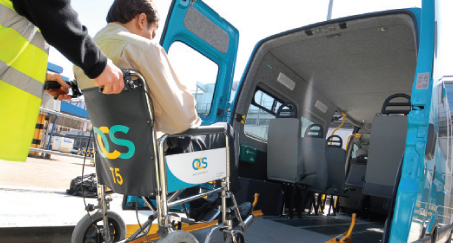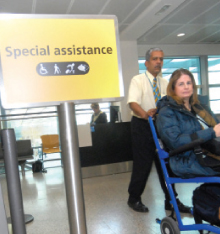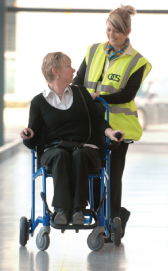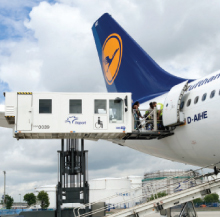
OCS has introduced the Resource Allocation System to improve responsiveness to PRM requests.
The Regulation was introduced in July 2008 with the purpose of improving accessibility to air travel for disabled persons and PRMs, ranging from the stage of booking through to arrival at the final destination.
“There have been improvements in most places – at most airports and at most airlines,” said Maria Nyman, policy officer, European Disability Forum. “Passengers are more aware of their rights and because of this they are more likely to see where there are gaps in the service they receive. It’s very positive that passengers with reduced mobility know they have these rights.

Nyman: “The training is not only essential but it’s also the most cost-effective means of ensuring the non-discrimination of passengers with reduced mobility.”
“The number of passengers with reduced mobility who travel by air has increased, but it’s important for us to ask how the service can be proactively improved. There are some gaps that need to be addressed in the Regulation itself, but we recognise that the implementation of a new Regulation is always a process and it’s bound to take time to get it right.”
One area of contention, she explained, is the fact that when mobility equipment is damaged in transit, the passenger is not necessarily entitled to compensation, while passengers with respiratory equipment are also not protected by the regulation.
“Also, the national enforcement bodies in governments often lack resources, such as office personnel, to deal with these specific issues and that’s a problem at the national level,” Nyman added.
Providing assistance

EU Regulation 1107/2006 was introduced in July 2008 to improve accessibility to air travel for disabled persons and PRMs.
In line with the Regulation, in Europe, services for the assistance of PRMs are contracted to the airport operator, where as outside of the EU, services are contracted directly with airlines.
In the UK and Ireland, OCS currently works as a contractor providing mobility assistance to passengers with reduced mobility at 10 airports, including Gatwick, Manchester, Birmingham and Dublin.
These services include meeting and assisting PRMs upon arrival at the airport, agreeing their needs and providing the necessary assistance, ranging from wheelchair or buggy assistance, to personal assistance for hearing or visually impaired passengers.
Steven Wheeler, OCS aviation director, explained: “There is no question that the introduction of EU Regulation 1107/2006 has resulted in a general improvement in service for PRMs. From a contractor perspective it has improved coherence in providing services and facilities at the airport, with opportunities to improve the passenger experience that were not previously available under airline contracts. It has enabled us to provide host desks, while staff planning is more efficient and responsive.
“The minimum quality of service is laid down by EU legislation and the clear requirements – in terms of responsiveness and wait times – means that the service can be easily understood and catered for.”
One of the ways in which OCS has improved responsiveness to PRM requests is through the Resource Allocation System. Based on INFORM, it is a real-time tool which reads passenger booking information from SITA, automatically updating with any changes, and matches passenger requirements against staff resources to ensure that customer needs are met.
Staff training
Nyman also highlighted staff training as a vital component of providing a seamless air travel experience for PRMs. OCS, for instance, offers NVQ (National Vocational Qualification) training to staff in areas such as customer service and disability awareness, and according to Nyman, such training is “essential” to ensure that the Regulation has the desired impact.
“The training is not only essential but it’s also the most cost-effective means of ensuring the non-discrimination of passengers with reduced mobility,” she said. “This training must also involve the disability organisations to ensure that it’s reflective of the needs of the passengers.”
While there is little doubt that the introduction of the EU legislation has positively impacted on the air travel experience for passengers with reduced mobility, both Nyman and Wheeler noted that there is scope for further improvement.
Nyman said: “From the airline perspective, the information must be better. Today, there’s a lack of accessible information and the booking system is complicated because you have to book assistance at a separate stage to booking your tickets.” Furthermore, ensuring that PRMs have the opportunity to make use of all airport facilities is also important to ensuring non-discrimination.
Wheeler added: “We can certainly be satisfied as an industry with the strides we have taken over a relatively short time in the provision of service to PRMs. There is, of course, still room for improvement, in communications, notification and understanding the needs of PRMs. However, considering that airports had limited knowledge of PRM operations prior to 2008 and no-one had faced the unique challenge of running such an operation across a whole airport, the development to-date has been exceptional.”
SideCat Highlifter for Aircraft

The unique aspect of the SideCat highlifter for aircraft is its ability to lift from zero to over 8m without pause, time-consuming stabilising measures or changing driver position.
CATCON technologies’ philosophy is to find compellingly simple and cost-effective technical solutions. The Austrian company develops, manufactures and services special vehicles for aircraft ground handling and related areas, focusing in particular on the award-winning SideCat.
The unique aspect of the SideCat highlifter for aircraft is its ability to lift from zero to over 8m without pause, time-consuming stabilising measures or changing driver position. The simple but revolutionary idea behind the SideCat is particularly effective for the Airbus A380. Being side-mounted, the SideCat easily reaches the necessary height of over 8m and can access the upper deck door, which is positioned unfavourably over the wings, without auxiliary aids.
“At this point in time, we are the only provider who can overcome this challenge without auxiliary constructions,” explains CATCON managing director Dieter Wertheim.
This all-rounder offers versatility too: it can be used for catering purposes or for transporting passengers in wheelchairs and VIPs who require separate access to the aircraft. The SideCat can be used as a work platform: with its waste compactor it becomes a waste disposal vehicle and with its stair extension it can deliver passengers to the A380 upper deck.
When the A380 paid its first visit to an international passenger airport in Frankfurt, the SideCat highlifter was employed, having been subject to extensive testing from the Airbus team. The SideCat proved its worth, and showed that it is perfectly suited to handling the A380. The vehicle’s flexibility has not only attracted the attention of airports, handling agents, catering companies and maintenance service providers, but also that of the German Innovation Award jury, who awarded the prize to CATCON. Airbus and Frankfurt airport (Fraport) are among its launch customers.







